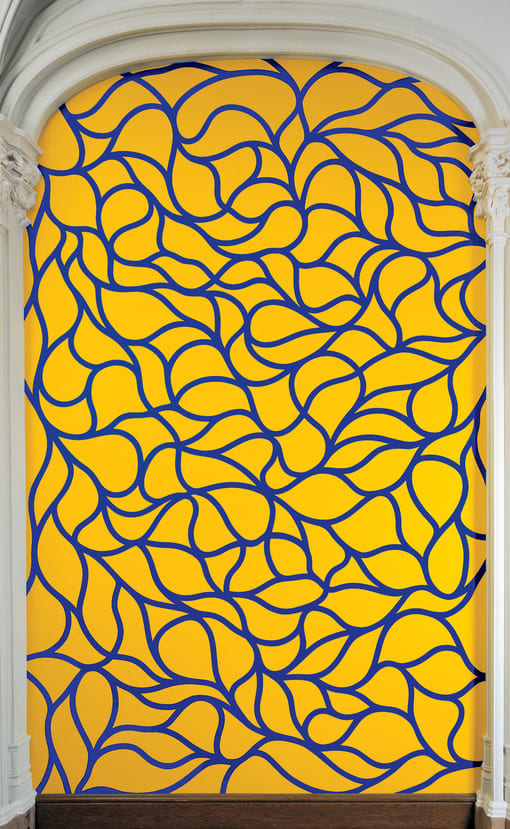
- Artist/Maker:
- Sol LeWitt
- Bio:
- American, 1928-2007
- Title:
- Wall Drawing #926 Loopy (yellow and purple)
- Date:
- 1999
- Medium:
- Acrylic paint
- Dimensions:
- 164 × 102 1/2 in. (416.6 × 260.4 cm)
- Credit Line:
- Gift of an anonymous donor
- Accession Number:
- 2000-28
- Copyright:
- © 2008 The LeWitt Estate / Artists Rights Society (ARS), New York
Not On View
Born in Hartford to Russian Jewish immigrant parents, Sol LeWitt pioneered the Conceptual Art movement at a time when art was reacting against the subjectiveness of 1950s Abstract Expressionism. LeWitt's objective methodology employs grids, serials, and sets of instructions, enabling one idea to generate multiple works. His typical strategy-finding and representing all combinations of a particular set of simple elements, such as lines, colors, or three-dimensional forms-creates finite series, the number of permutations predetermined by a preset number. By declaring the rules by which an image is created, LeWitt makes the image itself somewhat redundant, or even negligible.
To LeWitt, who seldom veers from these self-imposed rules, the most important principle is that the idea is central and the execution is secondary. While the idea itself, simple and logical, often ends up being perceptually illogical, perception is subjective and the artist is unable to perceive the work until it is complete. To eliminate what LeWitt calls "caprice, taste, and other whimsies," the idea must be predetermined. Having worked for I. M. Pei, LeWitt takes inspiration from the architectural process. Drawn first by him on paper, wall drawings are later executed by a team of studio assistants. As in architecture, the artist is separated from the actual construction of the art.
Breaking with the tradition of putting paint to canvas and canvas to wall, wall drawings, more than nine hundred of which exist today, are considered LeWitt's most innovative artistic achievement. His early wall drawings, first done in 1968, were simply transferred from drawings on paper, having no relationship to their environment. A major turning point occurred in 1970, when LeWitt created his first site-specific wall drawing. In the 1990s, LeWitt began using acrylics, a traditional painting medium that radically changed the aesthetic of the wall drawings. His exuberant designs of the 1990s feature intense hues, geometric arcs, and waves that push the boundaries of their architectural confines. The vibrancy of these works allows the wall drawings to stand up to their architectural surroundings, while LeWitt's most recent wall drawings engage their surroundings, using architectural elements as foils or as integral components. Throughout their development, LeWitt's wall drawings have retained their internal logic and serial sensibility while increasingly playing with geometry, sensuality, and color.
In 1999, LeWitt designed these two wall drawings for two bays of the west wall of The Jewish Museum's second-floor galleries, a space that still retains architectural details of the French Gothic-style Warburg mansion, which houses the museum. One wall drawing has a yellow background with purple arabesques. The other exhibits a complementary color scheme of a green background with blue. LeWitt chose the site for this wall drawing, decision befitting his recent interest in installing his abstract, decidedly modernist designs in space with historical references, a radical departure from his earlier, gridlike works that were meant to be installed in the "white cube" spaces of galleries and museums. The idea remained central to LeWitt's late work, as did strategies that refute the primacy of the artist and the notion of permanence in art.
To LeWitt, who seldom veers from these self-imposed rules, the most important principle is that the idea is central and the execution is secondary. While the idea itself, simple and logical, often ends up being perceptually illogical, perception is subjective and the artist is unable to perceive the work until it is complete. To eliminate what LeWitt calls "caprice, taste, and other whimsies," the idea must be predetermined. Having worked for I. M. Pei, LeWitt takes inspiration from the architectural process. Drawn first by him on paper, wall drawings are later executed by a team of studio assistants. As in architecture, the artist is separated from the actual construction of the art.
Breaking with the tradition of putting paint to canvas and canvas to wall, wall drawings, more than nine hundred of which exist today, are considered LeWitt's most innovative artistic achievement. His early wall drawings, first done in 1968, were simply transferred from drawings on paper, having no relationship to their environment. A major turning point occurred in 1970, when LeWitt created his first site-specific wall drawing. In the 1990s, LeWitt began using acrylics, a traditional painting medium that radically changed the aesthetic of the wall drawings. His exuberant designs of the 1990s feature intense hues, geometric arcs, and waves that push the boundaries of their architectural confines. The vibrancy of these works allows the wall drawings to stand up to their architectural surroundings, while LeWitt's most recent wall drawings engage their surroundings, using architectural elements as foils or as integral components. Throughout their development, LeWitt's wall drawings have retained their internal logic and serial sensibility while increasingly playing with geometry, sensuality, and color.
In 1999, LeWitt designed these two wall drawings for two bays of the west wall of The Jewish Museum's second-floor galleries, a space that still retains architectural details of the French Gothic-style Warburg mansion, which houses the museum. One wall drawing has a yellow background with purple arabesques. The other exhibits a complementary color scheme of a green background with blue. LeWitt chose the site for this wall drawing, decision befitting his recent interest in installing his abstract, decidedly modernist designs in space with historical references, a radical departure from his earlier, gridlike works that were meant to be installed in the "white cube" spaces of galleries and museums. The idea remained central to LeWitt's late work, as did strategies that refute the primacy of the artist and the notion of permanence in art.
Information may change as a result of ongoing research.